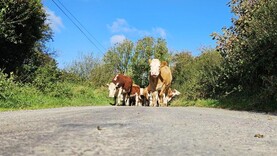The fallout continues from the news two weeks ago that the terminal index and replacement index will be updated, meaning a shift in rankings for different breeds.
Continental breeds look set to lose out most with traditional breeds receiving a boost.
The changes will come into effect in the November evaluation run which takes place on 21 November. I have received a huge number of phone calls from farmers very frustrated at the changes being implemented with many weanling producing farmers questioning the thinking behind the changes.
It also needs to be said that I have received calls from farmers who agree with the changes and the science that’s behind them.
During the first presentation last Thursday night, Margaret Kelleher from ICBF outlined the reasons behind the changes being implemented. It’s been eight years since the last updates were made to indexes and, within that time, market prices have changed including the costs of production.
New traits are being included and better methods and technology for evaluating different bulls and also policy changes. Greenhouse gas (GHG) emissions targets are also being factored into our breeding indexes to help meet the 25% target reduction in GHGs by 2030.
“Genetics is a trusted and proven technology that will deliver profitability and sustainability. Genetics has the potential to deliver 1.2m tonnes of GHG mitigation of the Irish Government’s 5.75m tonne requirements for agriculture,” Margaret said.
Donagh Berry outlined the changes to the terminal index.
Updated prices and costs have been included for calving difficulty. Increased labour, vet changes and lower subsequent performance after difficult calvings have meant a bigger negative in the updated indexes for difficult calvings.
Carbon costs have also been included in line with Government policy to reduce GHGs. New traits such as age at finish which has a 35% genetic influence, TB which has a 14% genetic influence and carcase specifications which have a 50% genetic influence have all been included.
Berry said: “While people talk about revenue from animals, very few talk about the cost of getting them there and we need to think more about the costs. We are price takers, so we should be focusing on what we can control inside the farm gate.”
Paul Crosson outlined the changes affecting the re-ranking of bulls in the replacement index.
He outlined how the changes would reduce the costs of carrying suckler cows through cow size and fertility, and increasing the value of the output through higher liveweight performance and better fertility while also reducing GHG emissions.
Feed is a huge cost in a suckler system and Crosson outlined how cow size and feed intake values are being factored into the updated indexes. Cull cow weight and carcase weight also have a higher value in the updated terminal index.
Changes
Siobhán Ring from ICBF outlined what the changes will mean for breeds. The new terminal index will result in easier calvings, shorter gestations, less calf mortality, heavier more conformed carcases, earlier finishing age, less feed intake and improved TB resistance.
The updated replacement index should result in more fertile cows, slightly lighter cows, easier calvings, shorter gestations, less calf mortality, earlier finishing age, less feed intake, improved TB resistance and slightly lighter carcases and less conformed progeny.
An important point was made that any cow that was an eligible four- or five-star cow in the BDGP will continue to be eligible under SCEP. Figures 1 and 2 outline the shift in breeds in each index.
The Limousin and Charolais breed see improvements in the terminal index with the Belgian Blue breed seeing the biggest drop from 25 bulls in the top 100 on the old index to 11 in the top 100 in the updated index.
On the replacement index, it’s a big win for traditional breeds with Aberdeen Angus moving from 29 in the top 100 on the old index to 46 on the updated index.
Herefords also see their rankings improve from two in the current index to 12 in the new index.
Over half of the bulls on the new top 100 replacement bulls list are from traditional breeds.
So, if you can have one sperm that is two stars and one sperm that is five stars is it all a game of luck?
Donagh Berry: “Yes, it’s all a game of luck. If we were so good, we would be exporting bulls around the world. It’s a game of luck and an analogous to horse racing.”
What difference does carbon make if farmers aren’t getting paid for it?
Paul Crosson: “It’s a good question and one which we discussed a lot. At this point in time, we are not paid or charged for carbon and that’s an important point to make.
“All of the traits have already been moving in the direction of a more carbon-efficient animal.
“We have a social obligation and a legislative obligation to remove carbon from all sectors of society, so this addition of carbon in the indexes is giving us a nudge in that direction.
“The last time we updated the economic figures for the indexes was 2015 so if you think about it within the next eight years, there will be a lot of discussion around carbon farming, the social licence to farm and there will be changes on how carbon is managed in society.
“We don’t know what the payment scale will be or what the opportunities will be but we need to future-proof the industry and our cow herd in terms of many different aspects and carbon is a really important one.”
With cow size getting smaller anyway, why are we including carbon and reducing cow size more?
Donagh Berry: “So, first of all, cow size isn’t decreasing. It’s actually increasing if we look at cull cow carcase weight, so what we are trying to do is stagnate that incline. People shouldn’t go away with the idea that we are looking for smaller cows, what we are actually trying to do is breed a quality calf without increasing the size of the cow.
“Calving difficulty is improving but we need it to improve faster. We don’t look at genetic trends and come up with the economic values. It’s the prices and costs of production that decides what emphasis to put on particular traits.”






 This is a subscriber-only article
This is a subscriber-only article










SHARING OPTIONS: